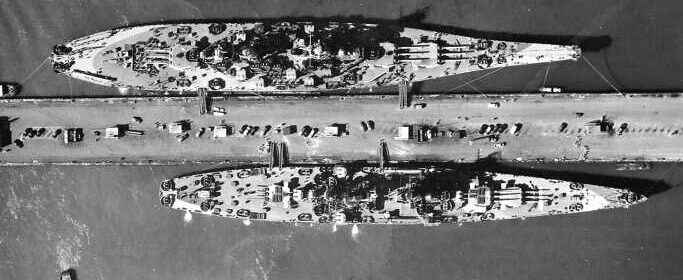The Oldest and Newest U.S. Navy Ships in WWII

Going into World War II, the United States Navy was far from being the powerhouse that it is today. In fact, in 1939 the Navy only had 15 battleships, five aircraft carriers, 18 heavy cruisers and 19 light cruisers as its major warships. However, over the course of the war, production would ramp up and the fleet would grow from roughly 700 commissioned ships to more than an astonishing 6,000 ships. (Also see, the most mass-produced U.S. naval ships in WWII.)
Part of the reason the United States got off to a slow start in WWII was the Washington Naval Treaty, signed in 1922, which hampered the production of warships to prevent an arms race. The treaty attempted to avert any major conflict in the wake of WWI. Instead, this treaty slowed down the Allied countries, which abided by it, from building up their naval might.
Over the course of WWII, the United States fielded a series of vessels, ranging from aircraft carriers to cruisers, that played a role in the Allied victory. Some of these vessels were developed entirely during the war, while others were older and underwent serious upgrades to keep them up to date.
To identify the warship classes of World War II, 24/7 Wall St. referenced the World War II Database, an online collection of data regarding the people, events, equipment, and ships of WWII. We ranked the ships by when they were first launched. For this list we only included aircraft carriers, cruisers, and battleships. Data regarding ship classes, type, crew, aircraft capacity, armament came from the WWII Database. We referenced third party military and historical sources to find the production runs for each class.
One of the older classes that participated in the war was the New York-class battleships, consisting of USS New York (BB-34) and USS Texas (BB-35). Each was designed and commissioned prior to WWII. These ships were initially introduced in 1912, but were upgraded and modernized to maintain their utility in the war. With the addition of anti-aircraft weaponry and improvements to their firing systems, they were a vital asset to the U.S. Navy.
At the other end, the Casablanca-class warships were some of the newest ships to join the fleet in WWII, having just been introduced in 1943. The Casablanca-class, like the USS Shamrock Bay (CVE-84), was the largest series of carriers in the Navy’s fleet, with a total of 50 vessels constructed from 1942 to 1944. Characterized by their smaller size compared to standard fleet carriers, these warships played a support role in various operations. Their versatility allowed them to engage in operations such as anti-submarine warfare, convoy protection, and providing air support for amphibious assault landings. (These are the biggest American naval battles of WWII.)
Noticeably on this list, the ships with the highest numbers of production are those that were actually produced in the later years of the war. These mainly included larger ships like aircraft carriers and cruisers, the production of which was prohibited under the terms of the Washington Naval Treaty. On the other hand, battleships tend to occupy some of the older spots on this list as they were primarily used during WWI. As technology improved and aircraft carriers rose to naval dominance, battleships became relatively obsolete for modern naval warfare.
Here is a look at the oldest and newest classes of U.S. warships used in World War II.
Sponsored: Tips for Investing
A financial advisor can help you understand the advantages and disadvantages of investment properties. Finding a qualified financial advisor doesn’t have to be hard. SmartAsset’s free tool matches you with up to three financial advisors who serve your area, and you can interview your advisor matches at no cost to decide which one is right for you. If you’re ready to find an advisor who can help you achieve your financial goals, get started now.
Investing in real estate can diversify your portfolio. But expanding your horizons may add additional costs. If you’re an investor looking to minimize expenses, consider checking out online brokerages. They often offer low investment fees, helping you maximize your profit.
Source: Read Full Article
